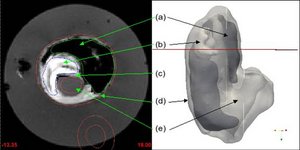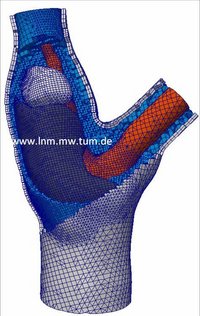Vulnerable Plaque of Carotis Stenosis
Joint project with the Clinic for Vascular Surgery at the university hospital Klinikum rechts der Isar.

Stroke is one of the most common reasons of death and permanent disability worldwide. 25% of strokes can be traced back to the rupture of an atherosclerotic plaque in the carotid bifurcation. Therefore critical carotid plaques are treated surgically in recent medicine. The treatment implies perioperative risk of stroke and that is why surgical indication for patients has to be improved. Thereby, modeling and simulation of local haemodynamics and mechanical stresses in carotid plaques is a promising approach. In this work, modern imaging techniques and application of Finite Element Methods (FEM) are used to investigate carotid plaques while different mechanical quantities are evaluated.

The Geometry is meshed hex dominantly (see Figure). The adventitial layer is extruded at the abluminal surface of the plaque mesh. Blood is modeled as a incompressible fluid. Material models for atherosclerotic tissue are taken from literature. FE fluid-structure-interaction (FSI) calculations are performed using the multi-physics solver BACI. Thereby, patient-specific measurements (luminal pressure and flow) are used to adjust the Boundary Conditions (BCs) that are implemented as Dirichlet-inflow and Windkessel-outflow BCs.